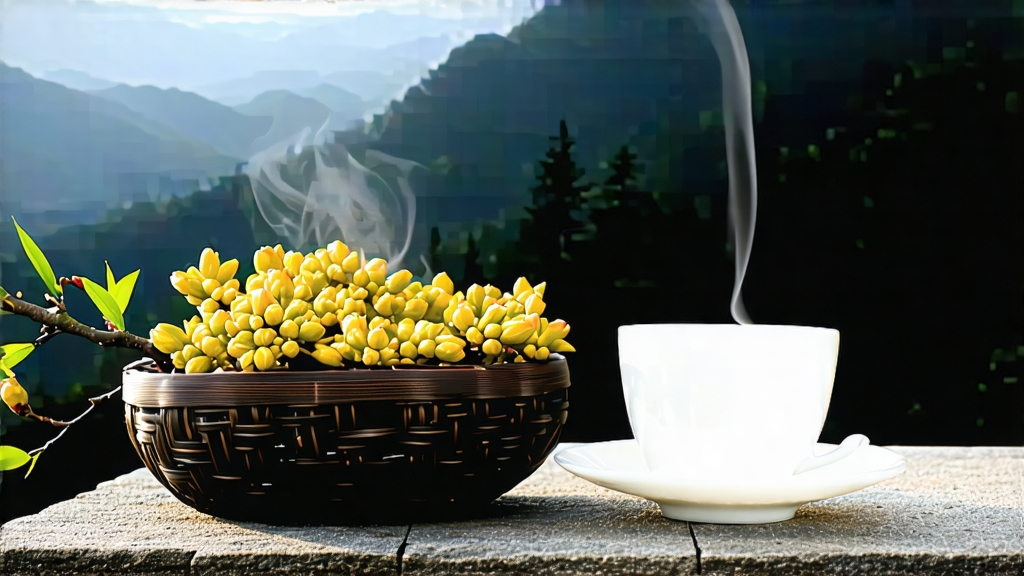
If oolong is the flamboyant actor of Chinese tea and pu-erh the venerable sage, then yellow tea is the discreet scholar who speaks only when the room is quiet. Among the sparse yellow family, Mengding Huangya crowns the list, born on the cloud-wrapped ridges of Mengding Mountain west of Chengdu, where Sichuan’s basin steam meets Himalayan winds. Its story begins in the Tang dynasty (7th century) when the Daoist monk Ganlu (“Sweet Dew”) planted the first bushes on the summit, believing the altitude—1 450 m above the fertile Chengdu plain—brought monks closer to the immortals. By the Song era the tender buds, wrapped in golden down, travelled 1 800 km along the Min River and Grand Canal to Hangzhou, where Emperor Huizong declared them one of the four “tribute teas” worthy of the Dragon Throne. For eight centuries the entire crop disappeared behind palace walls; commoners drank rough bancha while emperors sipped what poets called “liquid sunrise.”
Mengding Huangya is not a generic style but a single-origin cultivar—Sinensis var. alba—selected for its ivory-coloured pubescence and low tannin. Within the tiny harvest window (five mornings before Qingming in late March) only the unopened standard—one bud plus the infant leaf still folded like a paper fan—is plucked. A skilled picker gathers merely 200 g in an hour, the daily quota for one kilo of finished tea. Because the mountain is often fog-locked at dawn, pickers listen for the bell of the ancient Ganlu Temple; when the bronze tolls seven times they know the dew has dried enough to avoid enzymic bruise.
The magic that nudges the leaf from green to yellow is “sealed yellowing” (men-huang), a slow suffocation invented, legend says, by a forgetful Tang baker who left warm maofeng overnight in a linen sack. In modern parlance the process is three gentle dehydrations interrupted by two humid rests. First the buds are wok-fired at 160 °C for four minutes—just long enough to kill grassiness while keeping 65 % moisture. While still steaming they are wrapped in three layers: thick yellow calico, then a thin bamboo mat, finally a hemp blanket. This bundle is slid into a pine charcoal-heated closet kept at 28 °C and 85 % humidity for 50 minutes. During this sauna the leaf re-absorbs its own condensation, re-activating polyphenol oxidase but denying it oxygen; chlorophyll degrades into pheophytin, catechins dimerise into mellow theaflavins, and a hint of Maillard sugar appears. The cycle—brief dry heat, humid rest—is repeated once more, after which the buds are hand-rubbed along a bamboo screen to straighten them into tiny swords, then low-temperature dried at 55 °C until 5 % moisture remains. The entire choreography lasts 72 hours, three times longer than green tea, yet the leaf colour shifts only a few Pantone steps from jade to primrose, betraying nothing of the flavour revolution inside.
To brew Mengding Huangya you need calm water and steady hands. Begin with mountain spring water at 75 °C; hotter temperatures exaggerate tannin and erase the honey note. Pre-warm a tall cylindrical glass (tallness lets the upright buds dance). Use 3 g for 120 ml—about a level teaspoon of these feather-light buds. Pour the water in a high, thin stream so that the leaves tumble like snowflakes, then cover and wait 90 seconds. The first infusion yields a liquor the colour of young Sauternes, releasing aromas of fresh lychee, steamed pumpkin and a whisper of pine. The buds stand upright, tips pointing to the surface like miniature periscopes, a phenomenon locals call “the bamboo shoots waking.” Subsequent infusions—always 75 °C—can be lengthened by 30 seconds; the fourth still carries sweetness because the low-temperature kill-step preserved trehalose inside the bud veins.
Tasting follows a quiet choreography borrowed from the Mengding monks. First listen: lift the cup to ear level and draw a slow breath through the nose; the aroma should feel cool, as if you had opened a mountain granary at dawn. Next look: tilt the glass